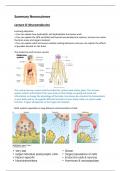Samenvatting
Summary neurosciences, brain as part of an organism
- Vak
- Neurosciences
- Instelling
- Vrije Universiteit Amsterdam (VU)
I passed this course with the help of these summaries with a 9! It contains all lecture material including all slides. NOTE: I used the anatomy slides that were given and the summary Antonio made. These are not included in this summary. This was sufficient!
[Meer zien]




